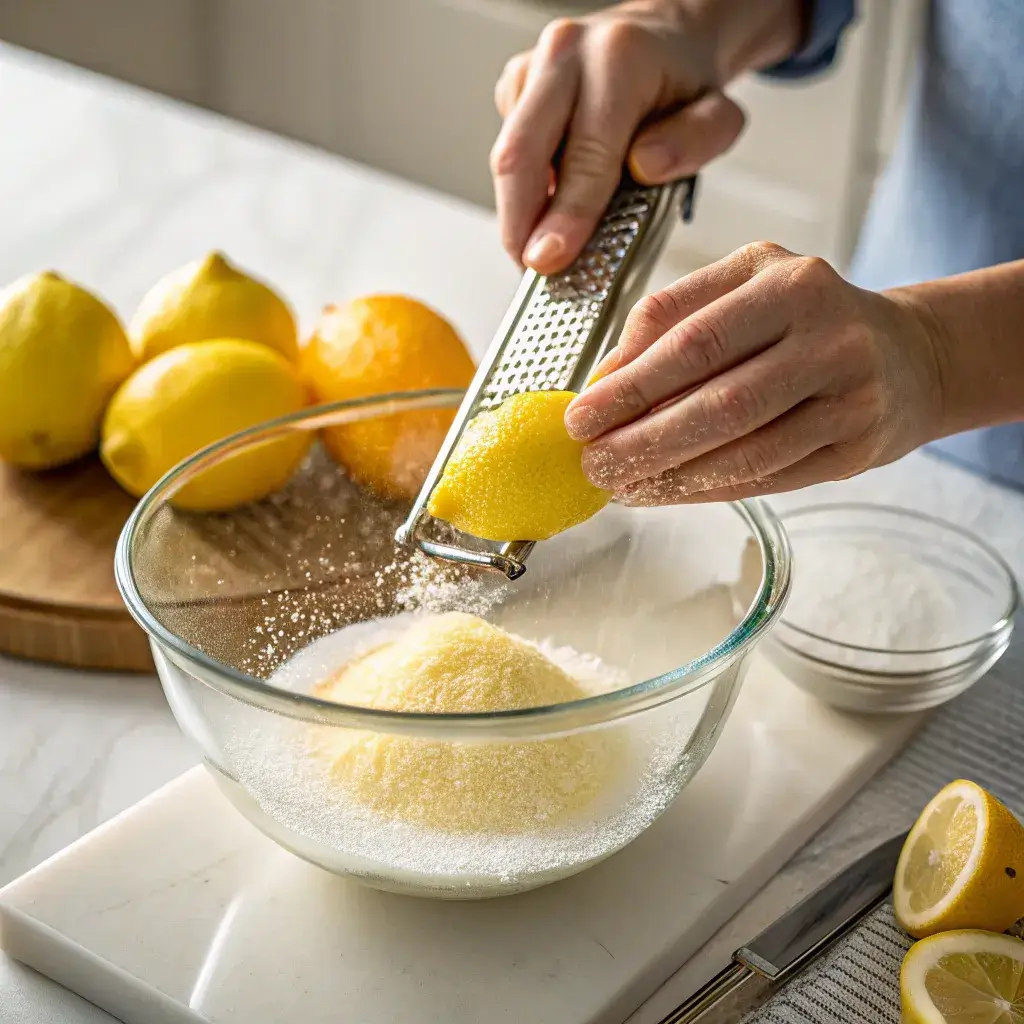Lemon lavender cookies are the perfect mix of bright citrus and subtle floral notes, wrapped in a soft, chewy, melt-in-your-mouth texture. They’re not just cookies; they’re an experience. Whether you’re planning a spring tea party, a summer dessert tray, or just want something unique to snack on, these cookies deliver big flavor with simple ingredients.
In this guide, we’ll cover everything from the best way to infuse lavender into your dough to easy substitutes if you’re out of fancy ingredients. You’ll get expert baking tips, optional glaze and decoration ideas, storage tricks, and answers to common questions like, “Can I refrigerate the dough longer than two hours?”
Why Lemon Lavender Cookies Are the Perfect Blend of Citrus and Floral
The Rising Trend of Floral-Infused Baking
Floral flavors like rose, hibiscus, and lavender have gone from niche to mainstream in just a few short years. What used to be seen as “experimental” is now featured in artisan bakeries, high-end cafes, and even grocery store products. Lavender, in particular, has found its sweet spot, pun intended in baking, offering a light, botanical essence that elevates basic recipes into something elegant and unexpected.
In cookie baking, floral ingredients create an elevated experience. When combined with a familiar taste like Lemon Lavender Cookies, the balance is just right, never overpowering, just enough to intrigue.
Why are floral cookies trending?
- Unique sensory appeal (taste and aroma)
- Aesthetic beauty (often paired with pastel tones)
- Elegant presentation for weddings, brunches, and holidays
Why Lemon Lavender Cookies Make a Perfect Pair
The brightness of lemon zest and juice balances the earthy, slightly minty tones of lavender. On their own, each flavor is powerful but together, they mellow into a well-rounded profile that works in both sweet and savory dishes.
In baking, that balance is key. Lemon’s acidity lifts the flavor of butter and sugar, while lavender offers a subtle fragrance and aftertaste that lingers pleasantly on the palate. The result? Cookies that are refreshing and refined ideal for both casual snacking and fancy occasions.
Flavor synergy at a glance:
| Ingredient | Flavor Profile | Function |
|---|---|---|
| Lemon | Bright, tart, fresh | Enhances sweetness, adds citrus punch |
| Lavender | Floral, earthy, herbal | Adds aroma, creates a sophisticated tone |
You’ll often see this combination in teas, cakes, and syrups but in cookies, it’s where the magic happens.
Looking for inspiration? Try our Cookies Dino recipe for fun, kid-friendly options.
Print
The Best Lemon Lavender Cookies – Easy Recipe with Glaze Tips
- Total Time: 27 minutes
- Yield: 24 cookies 1x
- Diet: Vegetarian
Description
Delicate and fragrant lemon lavender cookies with a buttery texture and subtle floral notes—perfect for tea time or a light dessert.
Ingredients
- 1 cup unsalted butter, softened
- 3/4 cup granulated sugar
- 1 large egg
- 2 tablespoons lemon zest (about 2 lemons)
- 1 tablespoon fresh lemon juice
- 1/2 teaspoon pure vanilla extract
- 2 cups all-purpose flour
- 1/2 teaspoon baking powder
- 1/4 teaspoon salt
- 1 tablespoon dried culinary lavender, finely chopped
- Optional: powdered sugar for dusting
Instructions
- 1. Preheat oven to 350°F (175°C) and line a baking sheet with parchment paper.
- 2. In a large bowl, cream together butter and sugar until light and fluffy.
- 3. Beat in the egg, lemon zest, lemon juice, and vanilla extract until well combined.
- 4. In a separate bowl, whisk together flour, baking powder, salt, and chopped lavender.
- 5. Gradually add the dry ingredients to the wet mixture, mixing until a soft dough forms.
- 6. Scoop tablespoon-sized amounts of dough and roll into balls. Place on baking sheet, spacing them about 2 inches apart.
- 7. Flatten each ball slightly with the bottom of a glass or your hand.
- 8. Bake for 10–12 minutes or until edges are just turning golden.
- 9. Cool on baking sheet for 5 minutes before transferring to a wire rack.
- 10. Dust with powdered sugar once fully cooled, if desired.
Notes
- Make sure to use culinary-grade dried lavender to avoid bitterness.
- For extra lemon flavor, add a few drops of lemon extract.
- Cookies will stay fresh in an airtight container at room temperature for up to 5 days.
- Prep Time: 15 minutes
- Cook Time: 12 minutes
- Category: Dessert
- Method: Baking
- Cuisine: American
Nutrition
- Serving Size: 1 cookie
- Calories: 110
- Sugar: 7g
- Sodium: 60mg
- Fat: 6g
- Saturated Fat: 4g
- Unsaturated Fat: 2g
- Trans Fat: 0g
- Carbohydrates: 14g
- Fiber: 0g
- Protein: 1g
- Cholesterol: 20mg
Keywords: lemon, lavender, cookies, floral dessert, tea cookies
Key Ingredients for Authentic Lemon Lavender Cookies
Using Culinary Lavender: How to Choose and Prep It Right
Before diving into the dough, you need to make sure your lavender is not just fragrant but edible. Not all lavender is created equal. You must use culinary-grade dried lavender, typically labeled as English lavender (Lavandula angustifolia). This variety is softer, sweeter, and lacks the bitter, soapy notes found in ornamental types.
If you’re purchasing lavender for the first time, check the label or source from a trusted supplier like organic grocers, online spice retailers, or specialty food stores. Never use lavender from craft stores or home decor sections, as these often contain pesticides or chemicals.

How to prep your Lemon Lavender Cookies:
- Grind it: Use a mortar and pestle or spice grinder to gently crush the lavender before use. This releases essential oils and ensures even distribution in the dough.
- Infuse it: Steeping dried lavender in warm milk (as you’ll learn in Part 3) softens its floral profile, infusing your cookies with a mellow, aromatic flavor.
Pro tip: Start small. Even culinary lavender can overpower if overused. Two tablespoons steeped in milk is usually plenty for a batch.
Zesting Lemon Lavender Cookies for Maximum Citrus Flavor
The lemon zest is where all the citrusy goodness lives. Unlike juice, which adds acidity and moisture, zest adds concentrated lemon flavor thanks to its essential oils. And yes, you need fresh lemons no bottled juice here.
Zesting tips to lock in flavor Lemon Lavender Cookies:
- Use a microplane zester or fine grater to remove only the yellow skin not the white pith underneath, which is bitter.
- Zest directly over your mixing bowl to capture every drop of aromatic oil.
- Combine zest with sugar before adding other ingredients. Rubbing zest into the sugar releases even more oil, intensifying the citrus punch.
Here’s a quick method for enhancing your dough:
| Step | Technique |
|---|---|
| 1 | Zest 1–2 large lemons directly into your sugar bowl |
| 2 | Use fingertips to massage zest into the sugar |
| 3 | Inhale deeply (that smell is pure gold!) |
| 4 | Continue with butter and eggs as per recipe |
Together, lavender and lemon zest form the aromatic foundation for our cookie base.
Don’t miss our 3-Ingredient Banana Bread with Cake Mix if you’re into quick bakes that still wow.
Making the Lemon Lavender Cookies Milk
How to Prepare Lavender Milk Like a Pro
One of the standout features of lemon lavender cookies is the subtle infusion of floral flavor, and that starts with a simple but effective step lavender milk. This method allows the floral essence to infuse evenly throughout the cookie dough without overpowering the other flavors.
Here’s a step-by-step guide Lemon Lavender Cookies:
Lavender Milk Recipe
| Ingredient | Amount |
|---|---|
| Whole milk (or dairy-free alternative) | ¼ cup |
| Dried culinary lavender | 2 tablespoons |
Instructions:
- Heat the milk in a small saucepan or microwave-safe bowl until it just starts to bubble.
- Remove from heat and stir in the dried lavender.
- Gently press the lavender into the milk using the back of a spoon to fully submerge.
- Let the mixture steep for 15–20 minutes.
- Strain through a fine mesh sieve, discard the lavender buds, and let the infused milk cool to room temperature.
This cooled lavender milk will be added to your wet ingredients, bringing in soft herbal notes without any bitterness.
Important Note: Avoid over-steeping, which can cause the lavender to release a medicinal or soapy flavor.
Don’t miss our Strawberry Dubai Chocolate recipe for more gourmet-flavored sweets.
Creaming Butter and Lemon Sugar – The Secret to Texture
Texture is just as important as taste, and the way you handle your butter and sugar is key to achieving that chewy center with crisp edges.
Creaming Tips for Perfect Cookie Dough
- Use unsalted butter at room temperature. This ensures proper aeration.
- Combine butter and lemon-infused sugar in a mixing bowl.
- Beat on medium-high speed for 2–3 minutes until the mixture becomes light, pale, and fluffy.
This process creates air pockets in the dough, resulting in cookies that puff up slightly and maintain a soft interior after baking.
Then add:
- 1 large egg + 1 egg yolk
- The cooled lavender milk
- 1 tsp vanilla extract (or vanilla bean paste)
- Optional: A drop of yellow gel food coloring for that sunshine hue
Mix until smooth and creamy.
Time to Add the Dry Ingredients Lemon Lavender Cookies
Once your wet mixture is light and fluffy, reduce the speed to low and slowly incorporate:
- 2½ cups of all-purpose flour (fluffed, spooned, and leveled)
- 2 tsp baking powder
- 1 tsp salt
Mix just until combined. Overmixing here can lead to tough cookies remember, you’re baking, not building bricks.
Pro Tip: Use a rubber spatula to scrape down the sides and bottom of your bowl to ensure even mixing without overworking the dough.
How to Bake Lemon Lavender Cookies Perfectly
Shaping, Rolling, and Spacing the Dough Balls
At this point, your dough is prepped and aromatic, filled with notes of Lemon Lavender Cookies. Now it’s time to portion, roll, and get those cookies oven-ready.

Here’s how to prep your cookies for baking:
1. Portioning the Dough
Use a 1½ tablespoon cookie scoop to measure the dough evenly. This ensures consistent baking and keeps your cookies uniform in size.
Want bigger cookies? Try a 3-tablespoon scoop and add 1–2 extra minutes to the bake time.
2. Lemon Sugar Coating
Before baking, you’ll roll each dough ball in a fresh batch of lemon sugar. This step adds a crisp, zesty coating that sparkles when baked.
Lemon Sugar Coating Recipe:
| Ingredient | Amount |
|---|---|
| Granulated Sugar | ½ cup |
| Fresh Lemon Zest | 1 tablespoon |
Use your fingertips to massage the zest into the sugar until it becomes aromatic and clumpy—that’s when the oils have been fully released. Then roll each dough ball until fully coated.;
3. Spacing on the Sheet
Place the sugar-coated balls 3 inches apart on a parchment- or silicone-lined baking sheet. These cookies spread slightly, and spacing helps them keep their shape and prevents sticking together.
Baking Time Tips: How to Get Chewy Centers and Crisp Edges
This is where things get delicious. Preheat your oven to 350°F (175°C). Bake your cookies for 10–11 minutes until:
- The edges are set and golden
- The centers still look slightly underbaked
That’s the sweet spot. Don’t wait until they look fully done residual heat continues baking them on the sheet after they’re pulled from the oven.
Cooling Instructions Lemon Lavender Cookies :
- Let cookies cool on the sheet for 15 minutes before transferring to a wire rack.
- This cooling time helps the cookies firm up without breaking and allows the flavors to settle in.
| Bake Size | Time | Yield |
|---|---|---|
| 1½ Tbsp | 10–11 mins | ~30 cookies |
| 3 Tbsp | 11–12 mins | ~16 cookies |
Check out our Wacky Lemon Cake for another citrus dessert with a twist.
BONUS: Optional White Chocolate Dip
If you want to elevate your lemon lavender cookies even more, consider dipping half of each cooled cookie into melted white chocolate, then topping it with lemon zest while the chocolate is still wet. This adds:
- Visual contrast
- Creamy texture
- An extra zing of lemon on top
Let dipped cookies set completely on wax or parchment paper before storing.
Lemon Lavender Cookies Sugar Glaze and Topping Ideas
How to Make a Simple Lemon Glaze (With or Without Lavender Syrup)
If you’re looking to finish your lemon lavender cookies with an elegant drizzle, a lemon glaze is the perfect touch. It’s glossy, sweet, and brings a tangy punch that pairs beautifully with the floral backdrop.
Basic Lemon Glaze Recipe:
| Ingredient | Amount |
|---|---|
| Powdered Sugar | 1 cup |
| Fresh Lemon Juice | 2–3 tablespoons |
| Optional: Lavender Syrup | 1–2 teaspoons |
Instructions:
- Sift powdered sugar into a bowl.
- Add lemon juice one tablespoon at a time, mixing until a pourable consistency forms.
- If using lavender syrup, replace part of the lemon juice for a sweeter, more floral tone.
No lavender syrup? No problem! Use a splash of vanilla or a tiny pinch of crushed culinary lavender steeped in warm water.
Drizzle the glaze using a spoon or piping bag once cookies are completely cool. Let them sit for 15–20 minutes so the glaze sets.

White Chocolate Dip and Lemon Zest Garnish
Another beautiful alternative to the glaze is a white chocolate dip:
- Melt 1 cup white chocolate chips or chunks.
- Dip half of each cooled cookie.
- Place on parchment paper and sprinkle with fresh lemon zest.
This not only adds sophistication to your presentation, but it also gives the cookies a little creamy richness that balances the citrus.
Smart Substitutions and Ingredient Swaps Lemon Lavender Cookies
Everyone bakes a little differently—whether you’re working around dietary needs or simply out of an ingredient, we’ve got you covered.
Dairy-Free, Gluten-Free, and Vegan Options
- Butter Substitute: Use plant-based buttery sticks for dairy-free cookies. Choose one that’s made for baking, like Earth Balance.
- Milk Substitute: Oat milk, almond milk, or coconut milk can be used to steep lavender instead of dairy.
- Egg-Free/Vegan: Use a flax egg (1 tbsp ground flaxseed + 3 tbsp water = 1 egg). Note that texture may vary slightly.
- Gluten-Free: Substitute all-purpose flour with a gluten-free 1:1 blend (like Bob’s Red Mill or King Arthur). Avoid almond flour—it alters texture significantly.
Don’t miss our Health Benefits of Lemons if you’re searching for more naturally sweet, worry-free recipes.
Lavender Alternatives for a More Subtle Flavor Lemon Lavender Cookies
If lavender isn’t your thing, you can still keep the elegance while softening the floral note.
Substitutes for Lavender:
- Chamomile (steeped in milk for a mellow herbal tone)
- Earl Grey Tea Leaves (for a lemon-bergamot twist)
- Thyme or rosemary (used sparingly, for a savory edge)
You can also completely omit the floral elements and enjoy a bright lemon cookie with all the zest and none of the botanicals.
Storage, Freezing, and Make-Ahead Tips Lemon Lavender Cookies
How to Store Freshly Baked Lemon Lavender Cookies
Once cooled and glazed, your cookies are ready for storage. Proper storage keeps them soft, chewy, and flavorful for days.
- Room Temperature: Store in an airtight container for up to 5 days.
- Refrigerated: If you’re in a humid climate, refrigerate in a sealed container for up to 7 days.
- Avoid stacking: If glazed or dipped, place parchment between layers to prevent sticking.
Freezing Cookie Dough vs. Freezing Baked Cookies
Want to get ahead on baking? These cookies are ideal for make-ahead prep.
Freezing Cookie Dough:
- Scoop dough into balls.
- Roll in lemon sugar.
- Freeze on a baking sheet for 1 hour.
- Transfer frozen balls to a freezer-safe bag or container.
- Bake from frozen just add 1–2 minutes to bake time.
Freezing Baked Cookies:
- Let cookies cool completely.
- Store in airtight freezer containers or wrap individually in plastic wrap.
- Freeze for up to 3 months.
- Thaw at room temperature and warm briefly in the oven for a just-baked feel.
Expert Tips to Make the Best Lemon Lavender Cookies
Common Mistakes to Avoid When Baking Lemon Lavender Cookies
Even with a great recipe, the wrong techniques can ruin the results. Here are some common missteps—and how to steer clear of them:
- Overmixing the Dough: After adding the dry ingredients, mix only until combined. Overworking the flour leads to dense, dry cookies.
- Using Decorative Lavender: Only use culinary-grade lavender. Decorative varieties may be treated with chemicals or taste too bitter.
- Skipping the Zest Rub: Don’t just toss in the lemon zest, rub it into the sugar! That’s where the real citrus magic happens.
- Overbaking: Cookies should look slightly underdone in the center. They’ll continue to bake on the sheet as they cool.

Professional Tricks for Flavor Boost and Presentation
- Chill Your Dough: If time allows, refrigerate dough for 30–60 minutes. It helps control spread and intensifies flavor.
- Uniform Scooping: Use a cookie scoop for consistent size and baking time.
- Finish with Sea Salt: A tiny sprinkle of flaky sea salt enhances the sweet, floral, and citrus balance.
Serving, Pairing, and Gifting Ideas Lemon Lavender Cookies
How to Present Cookies for Tea Parties or Gifts
Lemon lavender cookies aren’t just tasty they’re beautiful. Present them in elegant boxes or clear cellophane bags tied with purple ribbon. Add a tag with serving suggestions or a handwritten recipe card for a personal touch.
Perfect occasions for gifting:
- Bridal showers
- Mother’s Day
- Birthdays
- Hostess gifts
- Afternoon teas
Beverage Pairings: Tea, Coffee, and More
The flavor of these cookies plays wonderfully with both hot and cold drinks. Try pairing with:
| Beverage | Why It Works |
|---|---|
| Earl Grey Tea | Enhances the floral lavender notes |
| Lemon Ginger Tea | Amplifies the citrus elements |
| Coffee with Cream | Balances sweetness with richness |
| Iced Herbal Teas | Offers a refreshing contrast |
Serve with iced lavender lemonade on warm days or hot chamomile tea for cozy evenings.
Frequently Asked Questions Lemon Lavender Cookies
Can I refrigerate the dough for longer than 2 hours?
Yes! You can refrigerate the dough for up to 48 hours. Just let it sit at room temperature for 10–15 minutes before scooping and baking. The flavor deepens the longer it chills.
How to Make the Best Lemon Lavender Cookies?
Use culinary lavender, rub lemon zest into your sugar, don’t overbake, and consider a white chocolate dip or lemon glaze to finish. Chilling the dough is a bonus step for flavor and texture.
If I don’t want to make the lavender syrup, what can I use to substitute it in the glaze?
Use a mix of lemon juice and vanilla extract, or steep a small pinch of lavender in warm water and strain. You can also skip it entirely lemon glaze alone is delicious.
How Many Cookies Does This Recipe Make?
Using a 1½ tablespoon scoop, you’ll get about 30 cookies. With a 3 tablespoon scoop, expect 16 larger cookies. You can also halve or double the batch easily.
Final Thoughts on Lemon Lavender Cookies
These lemon lavender cookies are more than just a baked good, they’re a sensory escape. With a soft texture, sparkling lemon sugar crust, and a whisper of floral magic, they’re perfect for any occasion from a spring brunch to a thoughtful homemade gift. Whether you glaze, dip, or serve them straight from the oven, they’ll become a go-to in your recipe rotation.

